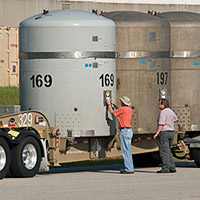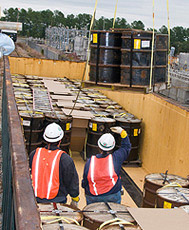 |
| Solid Waste Management employees verify data prior to shipping transuranic waste to the Waste Isolation Pilot Plant in Carlsbad, NM. |
Transuranic Waste
Transuranic (TRU) waste is waste contaminated with radioactive isotopes that have decay rates and activities exceeding defined levels. It contains man-made elements that are heavier than uranium and decay slowly, thus requiring thousands of years of isolation. TRU wastes can include equipment, protective clothing and tools used in the production and management of these radionuclides. In FY2009, 115 shipments including over 490 cubic meters of legacy TRU waste was shipped to the Waste Isolation Pilot Plant in New Mexico.
Low-Level Waste
Low Level Waste is any radioactive waste not classified as high level or TRU waste. Examples include slightly contaminated soil, D&D debris, protective clothing, job-control waste, equipment, tools, filters, rags and papers. In FY2009, 5,476 cubic meters of solid Low Level Waste were accepted for on-site disposal.
Hazardous Waste
The Resource Conservation and Recovery Act defines hazardous waste as any toxic, corrosive, reactive or ignitable material that could damage the environment or negatively affect human health. Some examples of SRS hazardous waste include oils, solvents, acids, metals, and pesticides. In FY2009, SWM disposed 179 cubic meters of hazardous waste at Environmental Protection Agency-regulated offsite treatment and disposal facilities.
|
Mixed Low Level Waste
Mixed Low Level Waste (MLLW) is waste that is both radioactive and hazardous. This type of waste is subject to regulations governing both waste types. In FY2009, the Mixed Low Level Waste program met all of its Site Treatment Plan commitments. The Site Treatment Plan represents an agreement among SWM, the Department of Energy, and the South Carolina Department of Health and Environmental Control to properly treat SRS’s mixed waste on a specified schedule. During FY2009, SWM disposed offsite 407 cubic meters of MLLW.
Sanitary Waste
Sanitary Waste (SW) includes both non-radioactive and municipal wastes (office waste, food, garbage, refuse and other solid wastes that are similar to those generated by most households) and typical industrial wastes (construction debris, scrap metals, wood waste, etc). During 2009, more than 85,000 tons of Sanitary Waste were disposed from SRS.
 |
| Drums containing depleted uranium oxide being loaded into railroad cars bound for a waste treatment plant in Utah. |
SRS has a recycling program using the City of North Augusta’s Material Recovery Facility (MRF). The MRF recovered about 1,000 tons of the municipal-type waste stream material in 2009 including white office paper, newspaper and magazines, cardboard, plastic, steel cans, aluminum cans and glass. Using the MRF resulted in SRS recovering and recycling about 40 percent from this part of the sanitary waste stream.
RETURN TO TOP |



